TRANSFORMATIONS OF QUADRATIC FUNCTIONS
Subscribe to our ▶️ YouTube channel 🔴 for the latest videos, updates, and tips.
A quadratic function is a function that can be written in the form
f(x) = a(x − h)2 + k
where a ≠ 0.
The U-shaped graph of a quadratic function is called a parabola.
Translation
f(x) = a(x − h)2 + k
Horizontal translation :
Moving the graph towards left or right.
h > 0, then move the graph right.
h < 0, then move the graph left.
Vertical translation :
Moving the graph towards up or down.
k > 0, then move the graph up.
k < 0, then move the graph down.
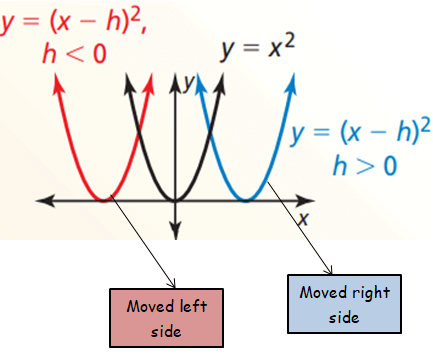
Reflection
Reflection across x-axis :
f(x) = x2
-f(x) = -x2
Reflection across y-axis :
f(x) = x2
f(-x) = (-x)2
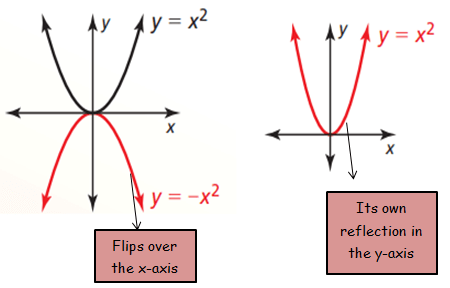
Shrinks and Stretches
Horizontal stretches and shrinks :
f(x) = x2
f(ax) = (ax)2
If a > 1 (horizontal shrink)
If 0 < a < 1 (horizontal stretch)
Vertical stretches and shrinks :
f(x) = x2
a f(x) = ax2
If a > 1 (vertical stretch)
If 0 < a < 1 (vertical shrink)
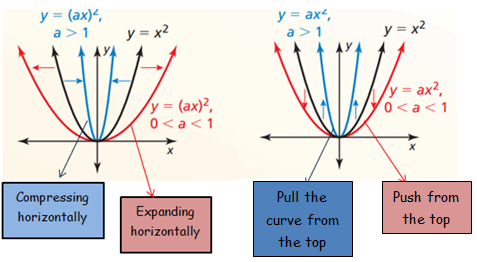
Problem 1 :
Which function includes a translation of 3 units to the left?
(a) f(x) = (x + 3)2 + 1 (b) f(x) = (x - 3)2 + 1
(c) f(x) = 3x2 + 1 (d) f(x) = (x + 1)2 - 3
Solution :
Considering the quadratic function in vertex form
y = a(x - h)2 + k
Here the value of h decides the horizontal movement. Since we move the curve left 3 units, the value of h will be -3
Option a :
f(x) = (x + 3)2 + 1
f(x) = (x - (-3))2 + 1
h = -3
So, option a is correct.
Problem 2 :
Which equation shows a translation of 3 left and vertical compression by a factor of 2 to the graph of y = x2?
(a) f(x) = 2(x - 3)2 (b) f(x) = (1/2)(x - 3)2
(c) f(x) = 2(x + 3)2 (d) f(x) = (1/2)(x + 3)2
Solution :
Translation of 3 units to the left. So, h = -3
Parent function is y = x2
Vertical compression means the curve will be observed towards y-axis.
Then, the value of a will be 0 < a < 1. Considering option d,
f(x) = (1/2)(x -(-3))2
h = -3 and a = 1/2 (0 < a < 1)
Problem 3 :
Which equation describes a parabola that opens downward, is congruent to y = x2, and has its vertex at (0, 3)?
(a) f(x) = (x + 3)2 - 1 (b) f(x) = -x2 + 3
(c) f(x) = -(x - 3)2 (d) f(x) = x2 + 3
Solution :
Parent function :
y = x2
Vertex is at (0, 3). So, h = 0 and k = 3
Opens down, then y = -x2
f(x) = -(x - 0)2 + 3
f(x) = -x2 + 3
Problem 4 :
List the sequence of steps required to graph the function
y = -(x + 4)2 - 6
(a) horizontal translation 4 units to the right, vertical compression by a factor of 1, vertical translation 6 units down
(b) horizontal translation 4 units to the right, reflection in x-axis, vertical translation 6 units down
(c) horizontal translation 4 units to the left, vertical translation 6 units up, reflection in x-axis
(d) horizontal translation 4 units to the left, reflection in x-axis, vertical translation 6 units down
Solution :
Considering the function y = -(x + 4)2 - 6 with y = a(x - h)2 + k
Since we have negative at the beginning, it must be reflection.
a = -1 (Reflection)
h = -4 (horizontal translation to the left)
k = -6 (vertical translation down)
So, option d is correct.
Problem 5 :
Which function matches the graph?
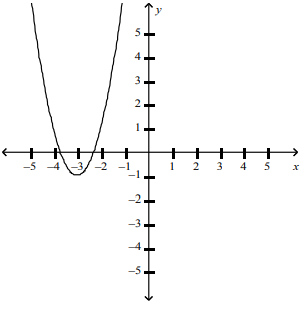
(a) f(x) = -2(x - 3)2 + 1 (b) f(x) = (x + 3)2 + 2
(c) f(x) = -2(x + 3)2 - 1 (d) f(x) = (1/2) (x - 3)2 - 1
Solution :
By observing the curve, the vertex is at (-3, -1).
So, (h, k) ==> (-3, -1)
In option c only, we have the given vertex. So, option c is correct.
Problem 6 :
Consider a parabola P that is congruent to
y = x2
opens upward, and has vertex (-1, 3). Now find the equation of a new parabola that results if P is reflected in the x-axis and translated 3 units down
(a) f(x) = -(x + 4)2 + 3 (b) f(x) = (x - 1)2 + 6
(c) f(x) = -(x + 1)2 (d) f(x) = -(x - 2)2 + 3
Solution :
Parent function :
y = x2
Since (h, k) is (-1, 3)
y = (x - (-1))2 + 3
Equation of quadratic function with vertex (-1, 3) :
y = (x + 1)2 + 3
Reflected in the x-axis, so y = -(x + 1)2 + 3
Translated 3 units down, so
y = -(x + 1)2 + 3 - 3
y = -(x + 1)2
So, the required function is y = -(x + 1)2, option c is correct.
Problem 7 :
The graphs of y = x2 and another parabola are shown below. What is a possible equation for the second parabola?
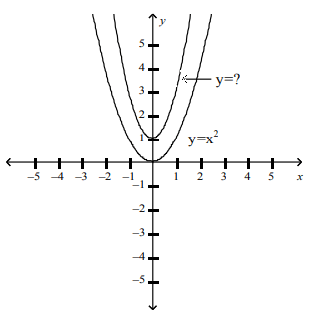
(a) f(x) = 2x2 + 1 (b) f(x) = (1/2)x2 + 1
(c) f(x) = 2(x + 1)2 (d) f(x) = -2x2 - 1
Solution :
Comparing with the parent function, y = x2
the translated graph moved 1 unit up and there is no horizontal translation. It looks like compression towards y-axis
The scale factor should lie in between 0 to 1. Accordingly options given, option b works for the given condition.
Problem 8 :
Describe the following transformations on the function y = x2.
y = -(x – 2)2
Solution :
Since h = 2 and a = -1
the graph should be reflected across y-axis and move the parent function 2 units right.
Problem 9 :
Describe the following transformations on the function y = x2.
y = (1/3)(x + 2)2 + 3
Solution :
Since h = -2, k = 3 and a = 1/3 (horizontal stretch)
the graph should be moved 2 units left, 3 units down and
Subscribe to our ▶️ YouTube channel 🔴 for the latest videos, updates, and tips.
Recent Articles
-
Finding Range of Values Inequality Problems
May 21, 24 08:51 PM
Finding Range of Values Inequality Problems -
Solving Two Step Inequality Word Problems
May 21, 24 08:51 AM
Solving Two Step Inequality Word Problems -
Exponential Function Context and Data Modeling
May 20, 24 10:45 PM
Exponential Function Context and Data Modeling